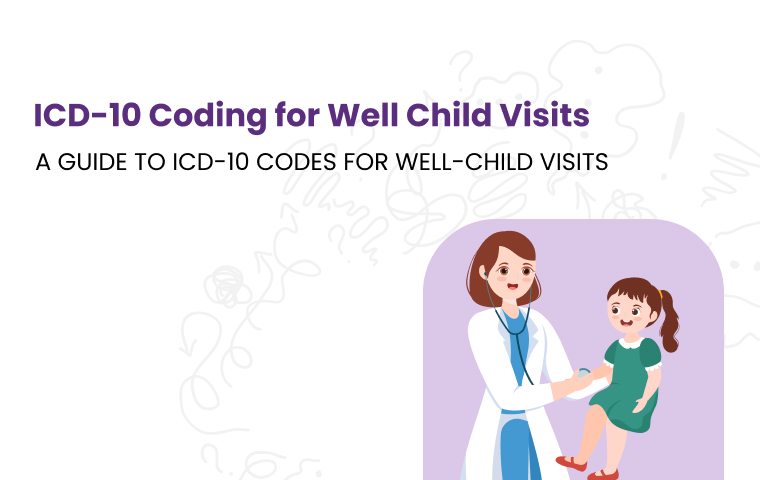Coding for well-child visits might seem straightforward at first glance, but these routine pediatric exams encompass a wide range of specificities. From monitoring growth and tracking developmental milestones to performing preventive screenings and administering immunizations, each component must be accurately documented and coded.
This complexity is compounded by the sheer breadth of ICD-10, which offers over 70,000 diagnostic codes—an eightfold increase from its predecessor, ICD-9. Selecting the right code for a routine health check, immunization, or common screening is no small feat.
Expert coders agree that having a comprehensive, well-structured guide to all aspects of well-child visit coding can turn this challenge into a manageable task. n this guide, we’ll break down the essential steps to selecting the right ICD-10 codes for routine pediatric care, immunizations, and preventive screenings.
ICD 10 Codes For Well Child Examination
When coding for well-child examinations, the ICD-10 system provides specific codes tailored to the child’s age group, reflecting the unique medical needs at different stages of development.
1. Well-Child Examination for Newborns Under 8 Days Old
In the first week of life, newborn well-child visits focus on evaluating immediate postnatal health. These visits include assessments of birth-related conditions, feeding adequacy, and the transition to life outside the womb. The ICD-10 code for this bracket is:
-
Z00.110: ICD 10 for Well Child Examination For A Newborn Under 8 days old.
This code applies to infants who are seen for a routine health check without any reported abnormal findings. Documentation should reflect the nature of the visit, including the examination of vital signs, growth metrics like weight and head circumference, and initial parental education on newborn care.
2. Well-Child Examination for Newborns Aged 8–28 Days
After the initial postnatal period, newborns enter a transitional phase, where well-child visits shift focus to monitoring growth, feeding patterns, weight and identifying any delayed post-birth complications. The ICD-10 code for this group is:
-
Z00.111: ICD 10 for Well Child Examination for a newborn aged 8–28 days.
This code is used for routine visits in this age bracket when no abnormal findings are present. During these visits, physicians typically review feeding success, check for signs of jaundice resolution, and ensure the infant's growth is on track.
ICD-10 Codes for Well-Child Examination for Children 29 Days and Older
As infants grow beyond their first month, well-child visits evolve to address developmental milestones, age-appropriate screenings, weight checks and routine immunizations.
1. Well-Child Examination for Infants and Children (29 Days and Older)
For routine health checkups in children 29 days and older, ICD-10 uses the following codes:
-
Z00.129: Routine child health examination without abnormal findings.
-
Z00.121: Routine child health examination with abnormal findings.
These codes apply to well-child visits for children at various stages of life, from infancy through adolescence. The distinction between Z00.129 and Z00.121 is crucial:
-
Use Z00.129 when the examination reveals no abnormal findings or concerns.
-
Use Z00.121 if the examination identifies any issues, even minor ones, that require further evaluation or follow-
When choosing between Z00.129 and Z00.121, ensure that any abnormal findings are clearly documented. Examples include growth delays, abnormal BMI, or developmental concerns.
Hearing & Vision Exam
The key aspects of hearing and vision exams, including the processes, abnormal findings, and implications of failed screenings.
Without Abnormal Findings:
If no abnormalities are identified during the routine vision examination, use Z01.00 (Encounter for examination of eyes and vision without abnormal findings).
With Abnormal Findings:
If the exam identifies any issues, such as refractive errors (e.g., myopia or hyperopia) or structural eye conditions, use Z01.01 (Encounter for examination of eyes and vision with abnormal findings) alongside codes for the specific condition
When a child fails an initial vision screening—such as one conducted at school or during a routine check—additional follow-up by a specialist is often required. For such situations:
-
Initial Screening Failure: Document with codes like H53.8 (Other specified visual disturbances) or R94.1 (Abnormal results of function studies of the eye and adnexa) to describe the failure.
-
Follow-Up Exam Without Abnormal Findings: If the follow-up examination reveals no underlying issues despite the failed screening, use Z01.020 (Encounter for examination of eyes and vision following failed vision screening without abnormal findings).
-
Follow-Up Exam With Abnormal Findings: If the follow-up exam identifies issues such as refractive errors or other conditions, use Z01.021 (Encounter for examination of eyes and vision following failed vision screening with abnormal findings), alongside the specific codes for the identified conditions.
ICD-10 for General Ear Check
The general ICD-10 code for an ear check, particularly when no specific symptoms or findings are yet documented, is Z01.1.
When a hearing or ear exam is performed and reveals no signs of structural or functional issues, the outcome is considered normal. For these encounters:
-
Use Z01.10: Encounter for examination of ears and hearing without abnormal findings.
-
Use Z01.11: Encounter for examination of ears and hearing with abnormal findings.
If the hearing examination is conducted due to a previously failed hearing screening, the appropriate code is:
-
Z01.110: Encounter for hearing examination following failed hearing screening.
ICD-10 Codes for Pediatric Lead Poisoning Screening
The proper coding for lead screening depends on whether it’s a routine preventive test or if there are specific concerns about lead exposure:
-
Routine Lead Screening Without Symptoms
-
Z13.88: Encounter for screening for disorder due to exposure to contaminants (includes lead screening).
This is the most commonly used code for routine preventive screenings for lead exposure.
-
Final Words
With the right understanding of age-specific codes, preventive screenings, and documentation for abnormal findings, you can ensure your practice stays compliant and efficient. Every detail, from weight checks to vision and hearing assessments, plays a vital role in delivering exceptional pediatric care.
However, staying on top of these details while managing your pediatric billing can be overwhelming. That’s where HMS USA LLC pediatric billing services comes in. Our dedicated pediatric billing experts handle the complexities of coding and claims, ensuring precision and timely reimbursements.
ABOUT AUTHOR

Pedro Collins
As a blog writer with years of experience in the healthcare industry, I have got what it takes to write well-researched content that adds value for the audience. I am a curious individual by nature, driven by passion and I translate that into my writings. I aspire to be among the leading content writers in the world.
